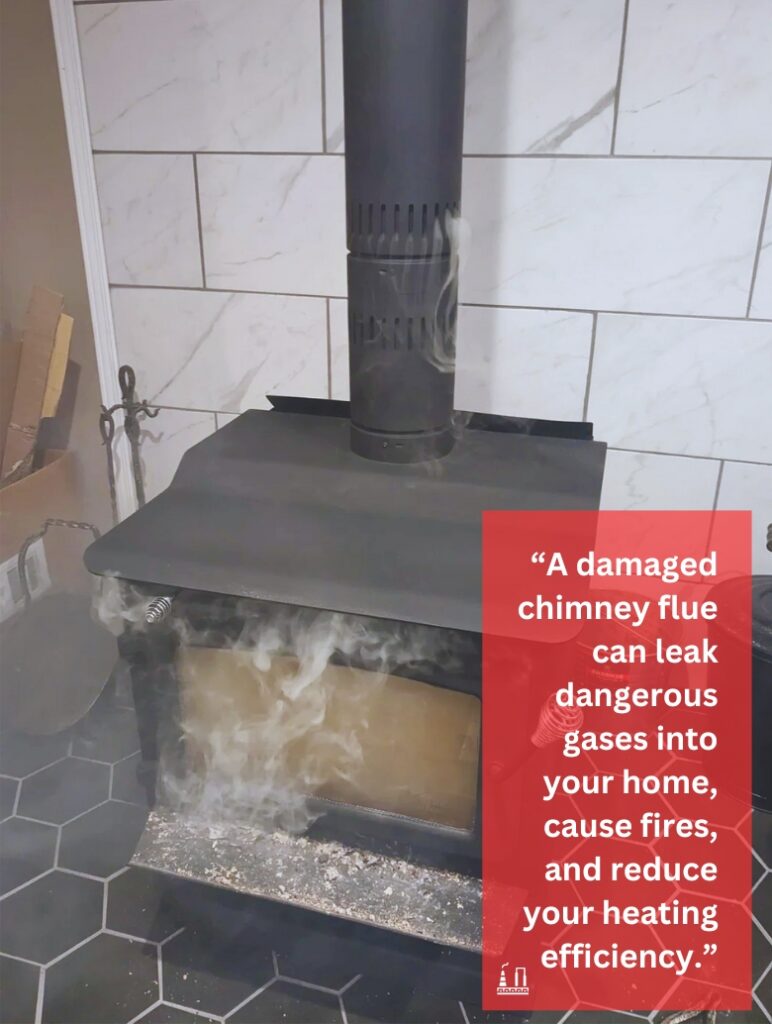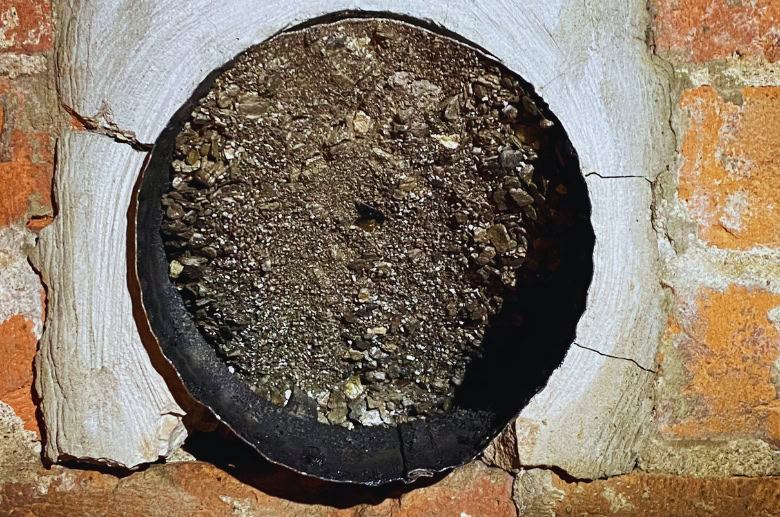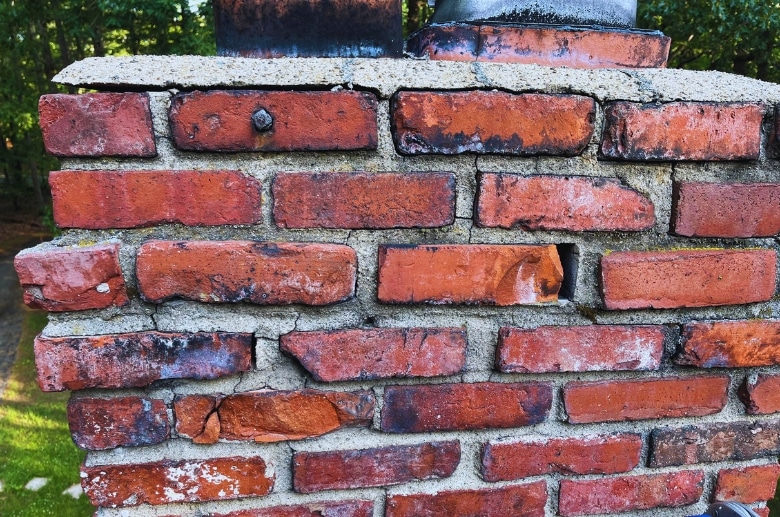Fireplaces are the heart of a cozy home, but neglecting your chimney flue can turn that warmth into a serious safety hazard. A damaged chimney flue can leak dangerous gases into your home, cause fires, and reduce your heating efficiency.

Fortunately, this guide is your one-stop shop for chimney flue repair. We’ll explain the telltale signs of trouble, explore effective solutions, and even give you a heads-up on potential costs.
Common Signs Of Chimney Flue Issues
Here are some common warning signs of chimney flue issues:
Cracks and Gaps
Take a close look at the chimney crown (the top) and the flue itself (the passage inside). Look for any cracks, large or small, in the mortar or brickwork. Gaps around the damper or flue liner can also indicate trouble.
These openings can allow water to seep in, damage the flue, and create pathways for smoke and gases to leak back into your home.
——
Do You Need to Hire Chimney & Fireplace Expert?
Get free quotes from qualified experts near you. No commitment required!
——
Deterioration
Exposure to the elements can wear down your chimney flue over time. Watch for signs of crumbling mortar, loose or missing bricks, and rust around the damper.
These signs indicate the flue is weakening and needs attention to prevent further damage and potential collapse.
Blockages

A blocked chimney flue is a major fire hazard. Blockages can be caused by a variety of things, including creosote buildup (a sticky tar-like substance from burning wood), animal nests, debris falling from above, or even a misplaced flue liner.
Signs of a blockage include a chimney flue gunk, difficulty starting or maintaining a fire, smoke spilling back into the room, and unusual odors coming from the fireplace.
The Dangers of Damaged Chimney Flue
Ignoring a damaged chimney flue isn’t just about aesthetics; it poses several serious risks to your home and your health. Here’s what you need to be aware of:
Carbon Monoxide Poisoning
One of the most significant dangers associated with a compromised chimney flue is carbon monoxide (CO) poisoning. CO is an odorless, colorless gas produced by incomplete combustion of fuels like wood or gas.
A damaged chimney flue, especially one with cracks or blockages, can trap CO inside your home instead of venting it outdoors. This can lead to CO poisoning, which can be fatal if left undetected.
Symptoms of CO poisoning include headaches, nausea, dizziness, and fatigue. In severe cases, it can lead to loss of consciousness and even death.
Taking action: If you suspect CO poisoning, evacuate your home immediately and call emergency services. Regularly maintaining your chimney flue and having a CO detector installed in your home are crucial steps in preventing this danger.
Increased Fire Hazard
A damaged chimney flue significantly increases the risk of a chimney fire. Creosote buildup, a flammable byproduct of burning wood, can accumulate within a cracked or blocked flue.
When exposed to high temperatures, this buildup can ignite, causing a dangerous chimney fire. Additionally, sparks and embers escaping through cracks in the flue can easily ignite nearby flammable materials.
Repair a cracked chimney flue and have your chimney professionally cleaned to remove creosote buildup. This will significantly reduce the risk of a chimney fire and ensure the safe operation of your fireplace.
Structural Damage

Gaps or cracks in the mortar or brickwork create openings for rainwater to seep into the chimney system. This water can damage the flue liner, deteriorate the surrounding masonry, and even leak into your home’s interior.
Over time, this water damage can lead to:
- Mold growth: Damp conditions within the chimney create a perfect breeding ground for mold, which can pose health risks and property damage.
- Deteriorated walls: Water leaking from the chimney can damage the walls surrounding the fireplace, leading to expensive repairs.
- Weakened structural integrity: In severe cases, extensive water damage can compromise the structural stability of the chimney, potentially requiring a complete rebuild.
——
Do You Need to Hire Chimney & Fireplace Expert?
Get free quotes from qualified experts near you. No commitment required!
——
Decreased Efficiency
A damaged or blocked chimney flue can significantly reduce the efficiency of a fireplace. Cracks, gaps, or blockages within the flue restrict the flow of exhaust gases, leading to poor drafts.
The poor draft makes it difficult for your fireplace to draw in sufficient air to properly combust the fuel. This results in incomplete combustion, which means you’ll be burning more fuel to produce less heat.
In essence, a damaged flue forces your fireplace to work harder for a weaker outcome, wasting your money on fuel and reducing the overall enjoyment of your fireplace.
Legal and Financial Consequences
Neglecting chimney flue maintenance can have legal and financial implications. If a fire or other damage is traced back to a neglected chimney, homeowners might face complications with their insurance companies.
Most homeowner’s insurance policies require regular chimney inspections and maintenance as a condition of coverage.
Additionally, regular chimney inspections and maintenance are often required by local building codes. Failure to comply with these codes can result in fines and legal issues.
Chimney Flue Repair Techniques
Now that you’re aware of the dangers posed by a compromised chimney flue, let’s explore some common repair techniques to address the problem and restore your fireplace to safe and efficient operation.
Relining
Chimney relining involves installing a new liner within the existing chimney. There are various relining materials available, each with its advantages:
- Stainless steel liners: These are a popular choice due to their durability, resistance to corrosion, and smooth surface that reduces creosote buildup.
- Cast-in-place liners: A special mold is inserted into the flue, and then a cement mixture is poured to create a new, solid liner. This method is suitable for oddly shaped flues or those with significant damage.
- Clay liners: Traditional clay flue tiles can be replaced with new ones. However, clay liners are more susceptible to cracking and deterioration compared to other options.
The process typically begins with a thorough inspection of the chimney to assess the extent of damage and determine the appropriate type of liner needed.
Once the suitable liner material is selected, the installation process begins. This may involve removing the old, damaged liner or placing the new liner directly over the existing one, depending on the condition. The liner is carefully fitted to the chimney’s dimensions, ensuring a snug and secure fit.
Relining is a complex process typically performed by a certified chimney sweep or mason. They will assess the condition of your flue and recommend the most appropriate relining material and method.
Tuckpointing and Sealing

Over time, the mortar joints between the bricks in your chimney flue can deteriorate due to exposure to heat and weather. This creates gaps that allow moisture to penetrate the flue, leading to further damage.
Tuckpointing and sealing are essential chimney flue repair techniques that preserve the integrity of mortar joints, safeguard against moisture penetration, and prevent structural deterioration.
Tuckpointing
Tuckpointing involves removing the old, damaged mortar and replacing it with new, high-temperature mortar specifically designed for chimneys. A skilled mason will carefully match the mortar color and texture to maintain the aesthetics of your chimney.
Sealing
Sealing is an essential repair technique that focuses on creating a protective barrier against moisture. Specialized sealants, such as waterproof coatings or silicone-based solutions, are applied to the chimney’s exterior.
These sealants form a resilient shield that prevents water from infiltrating the mortar joints.
However, sealing is generally considered a temporary solution and may not be suitable for extensive damage.
Spalling Repair
Spalling refers to the cracking, flaking, or detachment of brick or mortar from the chimney walls. This can be caused by exposure to extreme temperatures, moisture infiltration, or poor construction practices. Spalling can compromise the structural stability of the flue and should be addressed promptly.
Repairing spalling typically involves removing loose or damaged brickwork and replacing it with new bricks that match the existing chimney. Cracks in the mortar joints are addressed through tuckpointing, as described earlier. In severe cases, more extensive repairs or even rebuilding of the flue might be necessary.
Chimney Flue Repair Cost
The expense associated with repairing a chimney flue typically falls within the range of $200 to $1,000 or more. Various factors, including the following, influence this cost:
- The extent of Damage: Minor cracks or gaps might require simple sealing or tuckpointing. In contrast, a completely damaged liner or extensive spalling will necessitate more complex and expensive repairs, such as relining or rebuilding the flue.
- Type of Liner: Stainless steel liners are generally the most expensive option, followed by cast-in-place liners and clay liners.
- Labor Costs: The complexity of the repair job and the experience of the chimney professional will affect the labor costs. Relining, for instance, is a more involved process compared to tuckpointing and will likely incur higher labor charges.
- Location: Labor rates and material costs may be higher in some areas compared to others.
- Permits: Depending on your local building codes, you might need to obtain a permit before any chimney work can begin. Permit fees can add to the overall cost.
Here’s a breakdown of the costs associated with a chimney flue repair.
| Repair Type | Average Cost |
| Cracked flue tile | $200 – $1,000 |
| Chimney liner | $1,000 – $3,500 |
| Mortar repair | $200 – $800 |
| Flue cap replacement | $100 – $300 |
| Damper repair | $150 – $500 |
| Crown Repair | $300 – $1,000 |
| Tuckpointing and Sealing | $550 – $2,500 |
| Spalling Repair | $1,000 – $3,000 |
| Relining or Replacing Flue | $900 – $7,000 |
Note: Prices are approximate and can vary based on geographic location and specific circumstances. Always consult with a professional for accurate cost estimates.
How Do I Prevent Future Chimney Flue Damage?
Here are some essential steps you can take to minimize the risk of future damage to your chimney flue:
Regular Inspections
Schedule annual chimney inspections by a certified chimney sweep. This is the single most important preventative measure. A professional sweep will thoroughly examine your chimney flue for cracks, gaps, creosote buildup, and other potential problems.
Early detection of issues allows for timely repairs, preventing minor problems from escalating into expensive and potentially dangerous situations.
——
Do You Need to Hire Chimney & Fireplace Expert?
Get free quotes from qualified experts near you. No commitment required!
——
Cleaning and Creosote Removal
Regular chimney cleaning is another crucial step in preventing flue damage. Creosote, a sticky tar-like substance produced by burning wood, accumulates within the flue over time. This buildup can restrict airflow, reduce chimney efficiency, and, most importantly, pose a serious fire hazard.
The National Fire Protection Association (NFPA) recommends having your chimney cleaned at least once a year for fireplaces that are frequently used. More frequent cleaning might be necessary depending on the type of wood you burn, how often you use your fireplace, and the overall efficiency of your chimney system.
Waterproofing
Here are some ways to protect your chimney from moisture damage:
- Chimney flashing: Flashing is a specialized metal sheet installed around the junction where the chimney meets the roof. It diverts rainwater away from the chimney and prevents leaks. Ensure your chimney flashing is properly installed and in good condition.
- Water-repellent sealant: Applying a high-quality water-repellent sealant to the exterior of your chimney can further enhance its resistance to moisture penetration. Choose a sealant specifically designed for masonry surfaces and follow the manufacturer’s instructions for application.
Conclusion
This guide has equipped you with the knowledge to identify the signs of chimney flue trouble, understand the different chimney flue repair techniques available, and make informed decisions about addressing any necessary repairs.
Remember, the cost of preventative maintenance and timely repairs is significantly lower than the potential consequences of a neglected chimney flue.
Prioritize scheduling regular chimney inspections by a certified professional. Don’t hesitate to consult a qualified chimney sweep or mason for repairs or maintenance services. Their expertise is essential for ensuring the integrity and safety of your chimney flue and fireplace system.






